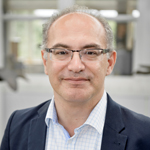

 Prof. Dimitri Argyriou
Prof. Dimitri Argyriou Prof. Dimitri Argyriou is Director of Science of the European Spallation Source (ESS) the top ESFRI project. ESS is currently under construction in Lund Sweden aiming at providing the brightest source of neutrons in the world. CARRIER HISTORY: 2009 - Habilitation, Rheinisch-Westfälische Technische Hochschule Aachen, Germany; 2002 - Senior Scientist, Helmholtz Zentrum Berlin; 1997 Visiting Scientist, Institut Laue –Langevin; 1994 – Staff Scientist, Argonne National Laboratory and Los Alamos National Laboratory;. 1994 - Ph.D. University of Technology, Sydney. AWARDS: 2010 - Friedrich-Wilhelm-Preis, RWTH, Aachen for multiferroic oxides; 2008 - Elected Fellow of the American Physical Society. Prof. Argyriou is a member of the beam time proposal review panel (structure) for the Spallation Neutron Source located at the Oak Ridge National Laboratory, USA and member of the beam time proposal review panel (structure) for the Forschungsneutronenquelle Heinz Maier-Leibnitz (FMR-II) and reviewer for beam time proposals for the US National Institute of Standards and Technology (NIST) center for neutron research. Dr. Frof. Argyriou is the author or co-author of more than 150 publications in international peer-reviewed journals with more than 4000 citations.
Neutrons have been called beautiful because of their varied and unusual properties. The Nobel Laureate Bertram Brockhouse said of neutrons that if we did not have them, we would need to “invent them” in order to study novel states of matter. The basic advantage of neutrons are that they are charge neutral and thus highly penetrating, they obey conservation laws that allow us to probe both the time and spacial domains of materials, they posses a magnetic moment that makes them a probe of choice to investigate magnetism in materials and finally the exhibit sensitivity to light elements. These properties allow us to use neutrons in a large variety of ways to examine materials from both the fundamental and technological perspective. It is for these reason that neutrons are deployed on a diverse scientific areas such as archeology to ecology, from high-temperature superconductors to lipid membranes and proteins. The European Spallation Source (ESS), currently under construction in Lund Sweden, will be the brightest source of neutrons in the world, opening new horizons for materials research and fundamental physics. We shall look at some of the innovations of ESS that will enable transformative experiments using neutrons as well as at current trends in science that ESS can potentially impact. Further, with the growing prospect that Greece also joins the ESS organisation we shall discuss opportunities for Greece in the construction and operations of this new facility.